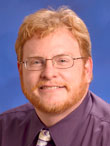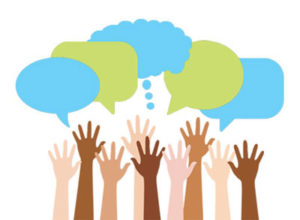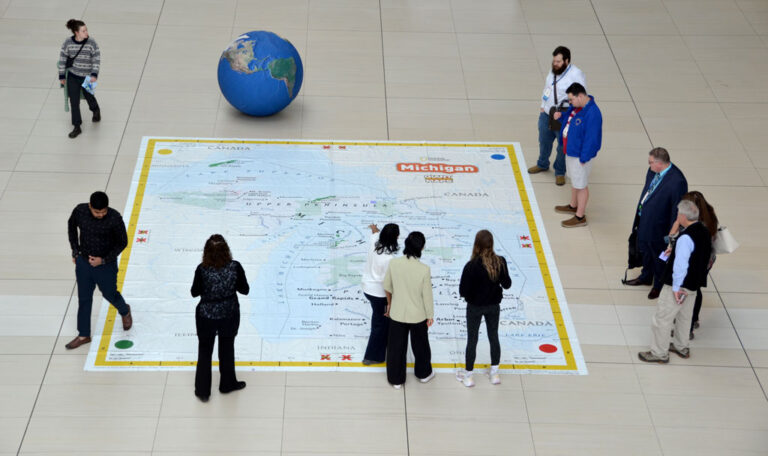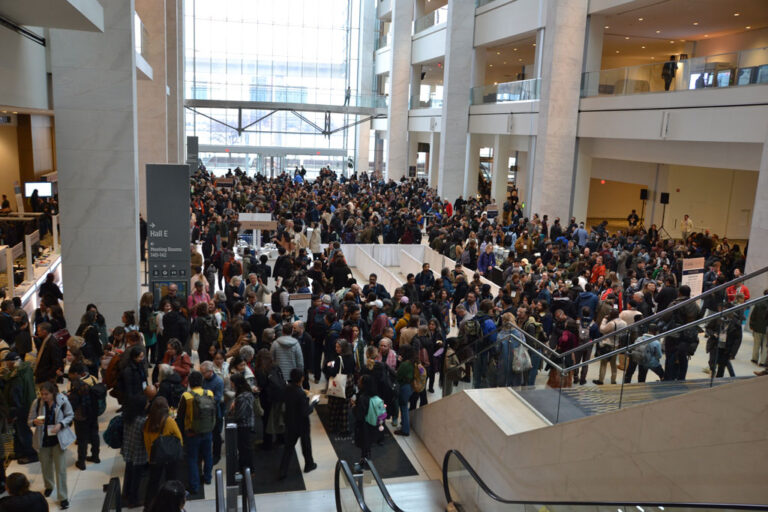Making AAG Meetings More Public

We are just days away from the start of the AAG annual meeting. I look forward to seeing many of you in New Orleans. For most of us, participating in the conference is work. It may be a labor of love, but it represents, nonetheless, a significant investment in terms of money, energy, and time. Please know that your investment and work on behalf of the discipline and the Association at the meeting is appreciated.
We attend the annual AAG meeting for a number of reasons — to present our latest scholarship, to learn about current theories and methods, to mentor and be mentored by others, to network within our specialty groups and knowledge communities, to collaborate on projects and publications, and of course to socialize with long-time friends and fellow alumni. These are all great reasons to attend; however, they tend to reinforce the idea that academic conferences are closed intellectual and social system devoted to cultivating relationships between colleagues and focused largely on building the research and teaching capacities of attendees.
No doubt, conferences should be about the work of building disciplinary bonds and expertise; however, I would suggest our meetings potentially offer an even wider array of professional interactions and benefits that open us to new places, people, and skills. In this column, I discuss the value, but also the challenges, of making our AAG meetings more public-oriented. By public, I mean at least three things.
- First, what can we do to develop a “public geographic ethics” for our conference host cities and to advance a critical understanding of the places within which we hold meetings, including the social and environmental struggles seemingly far from meeting rooms?
- Second, what can we do to host and include local voices within the annual conference and even create “community-conference collaborations” at meetings, recognizing of course the social and logistical issues that accompany this public engagement?
- Third, what can we do to create “conference workspaces” devoted to helping attendees develop skills, competencies, and political-ethical frameworks for carrying out public outreach, not only at the meetings but also back home within their own universities, industry workplaces, and communities?
Although what I have outlined above is a broad vision for enhancing the publicness of AAG meetings, there is already a history of some of these initiatives being carried out by geographers in the past. In addition, a number of AAG members and staff have worked hard to organize public-oriented activities and interactions in New Orleans. I encourage you to take advantage of and support these opportunities, some of which I highlight below. While these activities hopefully will enrich your time in New Orleans, it is my hope that they can inspire even greater strides toward public engagement at future annual meetings.
The Public Geographic Ethics of Attending a Meeting

The New Orleans meeting promises to be an intellectually and socially stimulating conference held in a city that offers geographers not only a place to have fun but also, importantly, a place to learn. Indeed, a number of papers, panels, field trips, and special sessions—including the opening, presidential plenary—are devoted to examining New Orleans’ geographies. The opening session, in particular, will focus on what geographers can learn from the range of racial, ethnic, class, and environmental struggles that have shaped New Orleans and how these struggles must inform any effort to imagine and plan the city in the future. We are very fortunate to have New Orleans Mayor-Elect Latoya Cantrell—the first woman to hold that position—join us at the opening session to issue a welcome and reflect on her own vision of the city’s challenges and future.
More than other types of conference goers, geographers are quite good at venturing outside of the meeting hotel to explore the host city and even collect photographs and personal observations of the area that can be incorporated into teaching modules and ongoing research. I suggest that the value of understanding and engaging with non-conference public geographies goes beyond simply what they give us in terms of information or touristic experience; rather, there is an ethical responsibility to know and care about the wider lived realities of the cities and regions that host our conferences.
As I have suggested in the rationale for my presidential plenary, the host cities for AAG meetings provide more than hotels, restaurants, bars, and other services. They offer important moments to delve into the scientific value but also the social needs of these locations and to educate ourselves about the historical and contemporary forces and tensions that shape their environments, communities and spaces. Doing so not only advances our academic understanding of place and region but also has the potential to create a more responsible and empathetic visitor and academic conference citizen—someone who can appreciate, analyze, and be affected by the people and places that exist beyond travel brochures found in hotel lobbies.
Geographers are no stranger to New Orleans, having contributed a great deal of critical analysis over the years—from the late Peirce Lewis’ classic book to the Clyde Woods’ path-breaking, posthumous volume, from the historical geographic work of Craig Colten and Michael Crutcher to the post-Hurricane Katrina analyses of Alice Huff, Catarina Passidomo, We Li and many others. Our honorary geographer for the 2018 meeting, Dr. Robert Bullard—one of the foundational figures in the study of environmental justice—has been a keen observer of the racially and spatially uneven nature of disaster response and recovery, both in the context of New Orleans and more generally throughout the United States. The inaugural Geographical Review lecture at the AAG meeting features Richard Campanella, a geographer with Tulane University and one of the most widely noted authorities on New Orleans landscape history.
Two of the AAG meetings’ featured themes, Black Geographies and Hazards, Geography, and GIScience — while certainly not limited to New Orleans — provide powerful lenses through which we can begin to achieve an ethical and place-sensitive interaction with the city. The 2018 AAG conference program includes, for example, sessions devoted to Critical Race Geographies of New Orleans and Hazards as a Way of Life in Louisiana. Gulf South Geographies of Freedom is a session that examines this very issue of the ethics of engaging and doing research in and around New Orleans and how such work requires a “sustained commitment” to place. This point prompts us to consider the long-term responsibility that AAG has to sensitize itself to the social and environmental challenges facing conference host cities, especially since the annual meeting tends to rotate among the same, limited number of venues that can accommodate our crowds.
When the Host Becomes a Guest
Especially important in making the annual meeting more public is to complicate the power dynamic of who is the host and who is the guest. It is important to create a two-way flow of engagement between community and conference, one in which local non-geographers can attend our meetings, contribute to discussions and debates, and benefit from participating in the conference and hearing about the work of geographers.
I am happy to report that several New Orleans-related sessions at this year’s conference are hosting local residents, scholars, and officials. This public participation will provide geographers insight into the experiences and perspectives of advocates, community leaders, policy institutes, non-profit organizations, and government agencies and possibly lead to opportunities in which we lend our collaboration and solidarity to pressing local issues. A session is organized to spark discussion between geographers and members of Blights Out, a New Orleans-based group using art, dialogue and action to address blight, housing affordability, gentrification, and housing as a human right. Representatives from the Gulf Coast Center for Law and Policy will join geographers and other practitioners for a roundtable at the 2018 AAG meeting that addresses how the concept of climate justice is co-produced by public and academic stakeholders and the implications of this work within “sacrifice zones” such as New Orleans.
An excellent example of the New Orleans meeting being used to form community-conference collaborations is the Emerging Workforce Scholars Program—now in its second year at AAG meetings. Under the leadership of Drew Lehman and as part of AAG’s Advancing Diversity initiative, local students and young adults from New Orleans’ ethnically and financially diverse communities are invited to be an integral part of the AAG’s annual meeting. This experiential learning program is designed to introduce local community members to careers in geography and the geosciences and to learn first-hand about job sites and career opportunities for geographers in the local area. The project is a result of partnership between AAG and Limitless Vistas, Inc., a New Orleans community-based organization devoted to helping “young adults obtain the skills and knowledge to become gainfully employed in the environmental or conservation industries.”
Cultivating public participation in the annual meeting involves more than simply issuing invitations and collecting PINs. Time and effort is expended identifying potential public participants (hopefully in consultation with local geographers or other knowledgeable people in the area), clearly explaining one’s expectations for the community partner’s participation, determining how the schedule of the AAG conference might accommodate the schedule of the community member, and building a social trust and rapport with the public partner.
By participating in the AAG meeting, local community partners quite likely will be sacrificing time away from family, pay from work, and some sense of security as they share views in meeting rooms and hallways filled with strangers. These partners may or may not be experienced with how academic conferences work or the conventions of speaking within sessions. Moreover, since Katrina in 2005, New Orleans’ communities have experienced the fatigue and frustration of being continually studied and analyzed by academicians, some of whom promise but fail to deliver on building long-term mutually beneficial relationships with communities they study. It is important, both at the 2018 meeting and beyond, to welcome the local community and treat them as a partner in the process of the geographic discovery rather than simply the subject or object of that discovery.
Also important is ensuring that there is something at the academic conference for the local community member — whether it is special sessions organized around a theme or issue of community interest, a social event in which locals can network with each other along with geographers with resources, ideas, and a willingness to assist and partner with public groups. Just as we use a “speed dating” method at AAG meetings to help connect people with potential employers or article authors with journal editors, our conferences might offer quick opportunities for local community organizations and civic leaders to talk with and receive free consultation from an array of attending geographers representing a variety of specialties and applied realms. A similar contact zone could be created between interested conference goers and area journalists, creating an opportunity for geographers to learn more about local issues but also getting the press in touch with scholars who can place these local issues in national and global context and thus inform public debate.
Public Engagement Skill Development at AAG meetings
The attention devoted at the 2018 meeting to learning about New Orleans and connecting with local voices and lives is related to one of the major goals and featured themes of the upcoming conference — public engagement in geography. Admittedly, engagement is an overly broad label to capture the many diverse ways that geographers communicate with and inform wider public audiences. While public engagement is about advancing broader societal understanding of the discipline through advocacy and promotion, it is also about establishing meaningful, reciprocal relationships with wider initiatives, struggles, and social groups. An engaged discipline also actively incorporates communities — as intellectuals and experts in their own right — into teaching, research, and service-outreach.
One of my goals for the New Orleans AAG meeting and the Public Engagement Theme is to create “conference workspaces” for developing skills and capacities in public engagement within our disciplinary ranks — recognizing that the vast majority of academicians and other geography professionals have never received formal training in this area. With the leadership of a wide array of talented facilitators, we have organized a series of Do-It-Yourself (DIY) Engagement sessions to address this void somewhat.
These DIY sessions are not workshops per se but are designed to provide grounded but critical discussions of public engagement and outreach opportunities, strategies, and challenges. Sessions build upon the experiences of panelists/facilitators and the sharing of perspectives from the audience to create a space where geographers can train each other, trade innovations and ideas, and negotiate practical and even political obstacles to public engagement in geography. The sessions, which cover a wide range of engagement arenas, are built upon the idea that geographers with a variety of styles and skills can make meaningful public interventions — whether large or small. The emphasis on Do-It-Yourself recognizes that while public engagement is a part of the Association’s strategic long-range plan, it is also the responsibility of individual geographers and geography programs and workplaces.
Below is a listing of the DIY Engagement sessions held in New Orleans and the details of their themes and facilitators/leaders. Links will take you to the sessions’ abstracts and placement within the AAG program schedule. Consider attending a session that resonates with you; we welcome attendees with limited engagement experience as well as veterans in these matters who can share their experiences and advise.
- How to Communicate Science and Geographic Knowledge (Led by Henri Grissino-Mayer, Marshall Shepherd)
- Bringing Students and Community Members Together in Shared Learning (Led by Joe Wood, Rebecca Torres, Naya Jones)
- Engaging Broader Publics via Op-eds and Opinion Pieces (Led by William Moseley, Joshua Muldavin)
- Teach-Ins (Led by Hilda Kurtz, Jenna Loyd, Punam Khosla, Ebru Ustundag)
- Effective Political Action, Evidence-based Advocacy (Led by Susan Walcott, John Wertman, Mia Renauld, David Butler)
- Entry Points for GIS in Public Pedagogy (Led by Rebecca Theobald, Kelley O’Neal, John Harner, Timothy Hawthorne, Michael Ratcliffe)
- Organizing for Positive Change (Led by Melanie Barron, Altha Cravey)
- Film and Filmmaking (Led by Jessica Jacobs, Keina Espiñeira, Christopher Lukinbeal, Pavithra Vasudevan, Julia Sickler)
- Pop-Up Public Programming & Storytelling (Led by Margo Shea)
As our discipline becomes more engaged publicly and our conferences create more opportunities to develop and debate the principles of an engaged geography, it will become increasingly important to rethink and widen the types of professional interactions and benefits we seek from our conferences. The DIY sessions have been organized in highly cooperative ways that stress the value of colleagues working together toward common goals and “coaching up” each other, which is admittedly not the vibe we necessarily get in all traditional sessions where scholars tend to operate autonomously and sometimes in competition with each other. Further development of these types of sessions will require not only a recognition of the general importance of public outreach but also a reconsideration of how the discipline operates socially and the value of further using the annual meeting to build a culture of mutual aid and support among our varied members of the geography public.
I am interested in knowing from AAG members about their impressions of the New Orleans AAG meeting, both in general but also specific to the theme of public engagement, as well as how ideas that geographers and others might have for enhancing the public nature of next year’s conference in Washington DC. Please share your thoughts and experiences by emailing me (dalderma [at] utk [dot] edu) or share on Twitter #PresidentAAG.
— Derek Alderman
Professor of Geography, University of Tennessee
President, American Association of Geographers
Twitter: @MLKStreet
DOI: 10.14433/2017.0033


